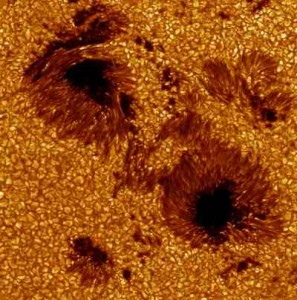
Observed with the Swedish 1-m Solar Telescope (SST). The SST is operated on the island of La Palma by the Institute for Solar Physics in the Spanish Observatorio del Roque de los Muchachos of the Instituto de Astrofísica de Canarias. Observations: Göran Scharmer and Kai Langhans, ISP. Image processing: Mats Löfdahl, ISP
Yes, the Sun has its spots!
And now you can take part in research that can help with some of solar physics’ unanswered questions, such as:
Are sunspots born complex or do they evolve to become complex?
Do sunspot groups that are more complex produce more eruptions?
There’s a new Zooniverse project now online called “Sunspotter.”
The Zooniverse is a collection of web-based citizen science projects that use the efforts of volunteers to help researchers deal with the flood of data that confronts them.
Sunspotter is essentially a game of hot-or-not for sunspot data.
A visitor of the site is shown two images of sunspot groups and asked which is more complex. All that boils down to information extremely useful in helping astronomers understand the physics of our star – the Sun.
A new batch of more than 200,000 images of the sun is now available on the site, with a request by Zooniverse officials to help rank them in order of complexity.
Science goal
According to the website, at the start of any research project, there’s a need to ask: What is the science goal?
The long term goal of the research is two-fold. In Sunspotter, the aim is to construct a reliable measure of sunspot group complexity. This means being able to take a picture of a sunspot group and say, from 1 to 10, how complex is this sunspot group?
“In the long term, we expect to develop a machine learning algorithm that will be able to determine the complexity of sunspot groups without the aid of humans,” explains the site.
Sunspotter volunteers will provide a dataset that will train the machine learning algorithm to do this.
“In the end, the volunteers will be the ones to thank for putting in the hard work and improving humanity’s ability to classify sunspots automatically!”
Put your shades on and eye this site:
By Leonard David
